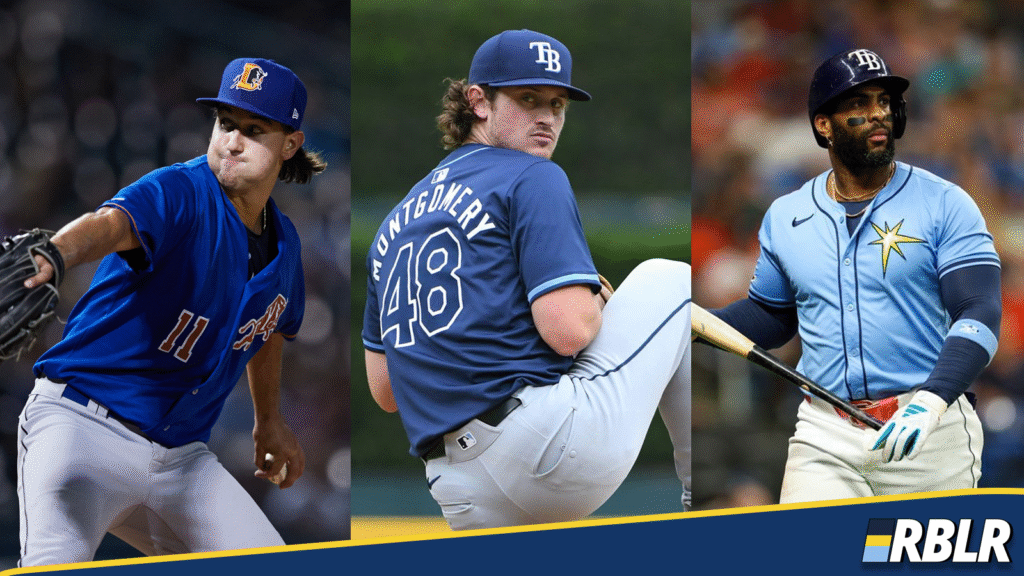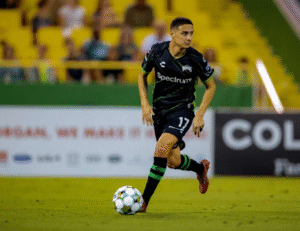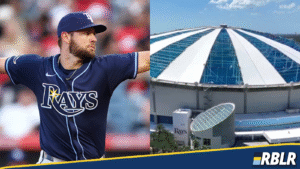RBLR Rays Roundtable #10 – Spot Starts, Hot Starts, and Slow Starts

This week, our writers examined who could be next to make the trip from AAA to take a turn in the rotation, why relievers have tough jobs, and the reason behind Yandy’s slow start.
Jacob Macauley (@raysfarmreport) : Spot Start for Seymour?
The Rays have shown a preference to have their starters throw coming off of five days of rest as opposed to the usual four days, and they could make another promotion to contribute as a “spot starter.” If they happened to do that, the Rays should give Ian Seymour the opportunity.
Seymour was awarded Rays minor league pitcher of the year last season, after his 3.30 FIP season across his 145.1 IP in AA and AAA. Seymour has picked up where he left off last season with a 26.8 K-BB% across his first 20 IP this season.
Ian Seymour has plenty of tantalizing pitches, showcasing an average fastball and slider, along with a plus changeup that has a 47.4 whiff% so far. Ian flashes unique mechanics, like Chris Sale, but throws over the top to offer unique looks for hitters. He has flashed plus command this season (posting a 4.9% BB%), but it has sometimes been a problem for him in his career.
For all of these reasons I think Ian Seymour offers an immense luxury that the Rays need to take advantage of at some point this season, in between stretches of consecutive games, to maximize their starting pitching output while also figuring out if some of these unproven players can succeed at the next level while the season is still young.
Dustin Teuton (u/FLBoy19) : Bullpen-ology
There is no more challenging job in Major League Baseball than being a reliever. In a sport with 162 games, relief pitchers are the only position judged off a small sample size. A full season for a reliever can be just 60 innings—over 100 fewer than a qualified starter—making their stats highly volatile.
One poor outing can drastically alter season-long numbers. If a reliever gives up four runs in both their first and first post-All-Star break appearances, but allows just 0.3 runs per outing over the other 58 innings, their ERA still lands at 3.80. Without the second blowup, it’s 3.26; without either, it’s 2.70. No position is more volatile than relief pitcher. That’s what makes every outing critical and early evaluations difficult.
The Rays bullpen has a 3.29 ERA, ranking 8th in MLB, but some relievers’ numbers are skewed by poor outings. Mason Montgomery has a 3.86 ERA through 7 innings, with all 3 earned runs coming in two outings. Remove his April 1st outing vs. the Rangers, and his ERA drops to 1.50. Hunter Bigge’s 4.00 ERA drops to 2.00 without his April 12th appearance against the Braves. Edwin Uceta’s 6.43 ERA is inflated by one 2-run outing—without it, he’s at 4.50.
These examples show why early-season stats can be misleading and why looking at non-traditional pitch modeling and pitch tracking stats is needed to provide nuance to relief pitchers’ stats. Montgomery might be the nastiest relief pitcher in baseball as he leads MLB in chase percentage and generates whiffs at a 38.6% rate—good for the 96th percentile, as well as leading MLB in Stuff+ at 134. Bigge has an above-average 27.8% whiff rate and just a 5.6% walk rate, flashing above-average stuff and control. Uceta continues to post elite chase rates, even though his swing and miss isn’t currently at his 2024 levels. Some of his issues early on are due to poor HR luck (2.57 HR/9 vs. 0.91 career).
It’s early, but all three have the tools to become key bullpen contributors, and it’ll be exciting to track their progress over the next five months.
Seth Hibel (@sethhibel10) : Yandy’s Slow Start
Through 20 games, the 2025 Rays are 8-12 and as a team are slashing .263/.328/.407/.735, with a Chase% at 28.2% and K% of 22.3%. Looking back at 2024, the Rays through their first 20 games were 12-8 with a slash line of .241/.307/.351/.658, with a Chase% at 30.1%, and K% of 30.1%.
The point here is that baseball is not fair. The Rays have improved tremendously in our small sample compared to last season’s start, yet most fans have a sour taste left in their mouth. These are good signs of better results to come. I think the record discrepancy mimics Yandy Diaz’s start to 2025 compared to his 2024; it looks the same, but he deserves better.
In 2025, Diaz is slashing .207/.250/.354/.604, while in 2024 through 20 games he was at .225/.276/.313./.589. Again, we are looking at a 20-game sample where one walk is the difference in 26 OBP points. Although when we look at batted ball info, Yandy has an 8.57 barrel%, which would be considered average, and in 2024 it was 2.94% – which is awful. 2025 Yandy has gotten out to the same slow start, but in 2024, he still had his patience. In 2024, Yandy had 87 PAs and saw 370 pitches (4.25 P/PA). 2025 Yandy has had 88 PAs and has seen 334 pitches (3.80 P/PA). This may not seem like a big difference, but it is; one pitch in an at-bat can swing the outcome in favor of the batter or pitcher.
This also explains the funk Yandy has been in with his approach at the plate – chasing at a 32.2% clip (league average sits at 28.5%) while his career average is 20.5%. Once Yandy settles back in at the plate with his elite vision, we’ll see him look more like 2024’s second half and 2023 Yandy. This is yet another example of how the numbers can deceive us. Yes, the slashline is similar, but Yandy is off to a much stronger start, making hard contact. It should be a much quicker turnaround in 2025 than in 2024 for Yandy Diaz.
The RBLR Rays Roundtable is a weekly collection of analysis, insight, and perspectives from a cast of writers assembled because of their unique backgrounds and experience. Check this space weekly for new updates and features covering the Tampa Bay Rays, the Rays’ minor league prospects, and more!







